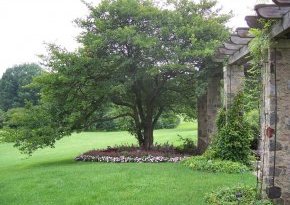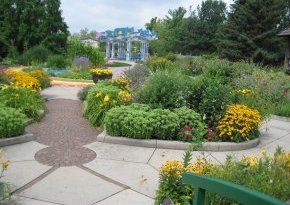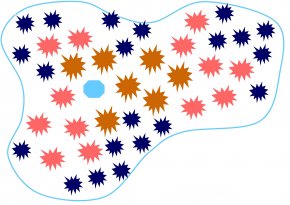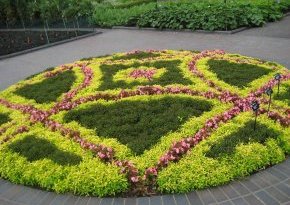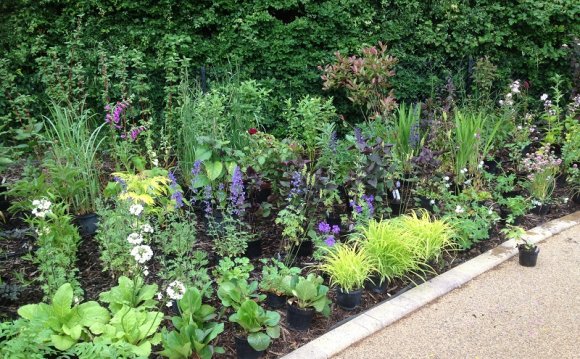
In general, plants in borders are arranged with tall plants (taller than 2 to 3 feet) placed in the back, mid-size plants (10 inches to 2 to 3 feet tall) in the middle, and short plants (less than 10 inches) in the front of the bed. It is best to use groupings or drifts of plants for a natural feel. Look at the border planting plan below. Tall plants are in brown, medium-tall plants are in blue, medium-short plants are in teal, and short plants are in dark green. Note that the plants are grouped rather than in rows.
The other thing to consider when planning your plant placement is that it is often best to use groupings of at least 3 of the same plant together. One plant alone often does not have enough impact, where a grouping of 3, 5, 7 or more will have good impact. Odd numbers tend to look better than even numbers. This is especially true of smaller plants where groups are necessary to have impact. Short plants can be used in long narrow plantings to create borders on the edge of a bed.
There is an exception to the plant 3 or more plants rule. In general, if a plant is large enough, think shrubs or large perennials, it can hold it's own without being grouped with other plants. Usually, only back of the border plants can stand alone. Scroll back up to see photos of borders.
Island beds work on the same principles as borders, but rather than having the taller plants in the back. The taller plants are in the middle of the bed or centered on the anchor plant. In the design below, the bright blue dot is the anchor, the brown are the tall plants, the pink are the medium plants, and the dark blue are the short plants.
You will note that the plants are grouped in drifts with the taller plants in the middle of the bed and then getting progressively shorter as you get toward the edge. Your design doesn't need to be rigid, you can see above that some medium sized plants come to the edge of the bed and some short plants are right next to tall plants. The tall to short progression is simply a rule of thumb, not a hard and fast rule. Scroll back up to see photos of island beds.
Let's talk now about the two styles of garden. Gardens generally are either formal or informal. Formal gardens tend to use distinct geometric shapes for their layout ; circles, rectangles, triangles or long straight lines. Plant spacing, color, and layout are all very precise. Here are some examples of formal gardens:
On the left is a circle knot garden, in the center is a formal garden with lots of color, but very geometric shapes, and on the right is a formal garden with a clipped boxwood hedge to create the form of the beds. All of these photos were taken at the Missouri Botanic Garden.
Source: www.provenwinners.com
Landscaping Tips
Though your home is your castle, there is no necessity to surround it with a moat. Here are 5 tips that will help you to make your landscaping feel more warm, welcoming and cozy.
1. Put some flowers nearby your entrance. Flowers make any area look more welcoming and attractive, so greeting your guests with Petunia, Snapdragon, Lily-of-the-Nile or some other garden flowers is always a great thing to do. What is more, to add some space between your house and the entrance, you can consider adding a little white fence. It will create an illusion that your front yard is bigger than it actually is. What is more, adding fence will create a great space for planting flowers to add some color and coziness.
2. Add rambling vines to make your yard look absolutely lovely. You can not deny that rambling vines always create romantic and even magical atmosphere. So why not to use this tip while decorating your yard?
3. To hide the unattractive driveway, consider adding some color, texture, and height. You can easily do it by adding various sorts of flowers. To start, create an island of green lawn right in the hub of a drive. Then add a couple of low boxwood hedges with flowers toward the back of your island.
4. If you want your yard to blossom and flourish bust still do not have enough time to maintain it, consider planting low-fuss lilies. Such flowers look absolutely gorgeous and come in the variety of rainbow hues, so you can pick the one you love most. What is more, low-fuss lilies do not care about the sort of soil, they love the sun and welcome hot, they do not afraid of drought. In other words, Crinums is an ideal flower for all those who are looking for low-maintenance solutions.
5. The last tip also touches the low-maintenance aspect. To make your life easier, group plantings into beds and islands. This will help you to avoid mowing and trimming around each individual plant, save a lot of time and even money.

